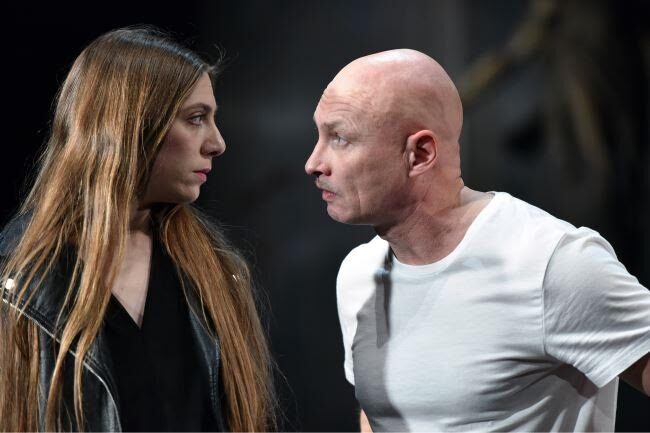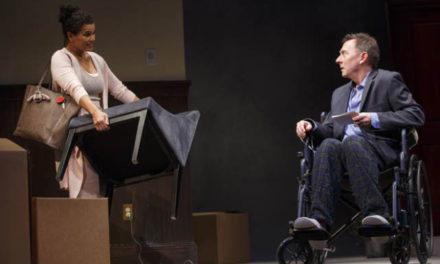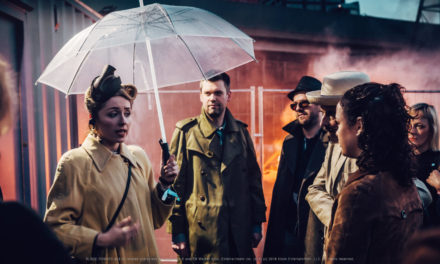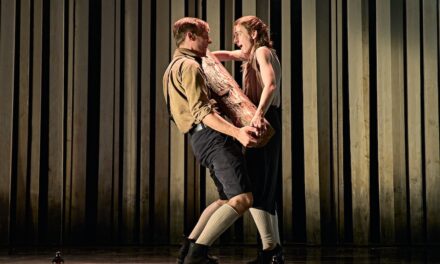“The theatre is a device for empathy – its job is to create better people.” Those are the words of Simon Stephens, one of Britain’s foremost, contemporary dramatists. His plays include Heisenberg, Birdland, Punk Rock, Harper Regan, Pornography, Motortown, and i Bluebird, which have been successfully staged at some of the world’s most renowned theatres.
Stephens’s latest play Maria, commissioned by Germany’s Thalia Hamburg Theatre where it premiered a year ago, was performed by the Slovensko narodno gledališče in Ljubljana (translated by Tina Mahkota) at the beginning of this year. This excellent, contemporary drama was successfully interpreted by playwright Darja Dominkuš and director Janusz Kica, and they have cast Eva Jesenovec as Maria with good reason.

Eva Jesenovec and Silva Čušin. Photo by Peter Uhan.
Maria is a play about solitude and loneliness in the 21st century. It tells the story of Maria–Ria, a pregnant eighteen-year-old who plans to give birth to her baby. Even though it seems at first glance that Maria is a typical teenager growing up in cruel, neoliberal times that destroy small port cities like the one she lives in, she’s actually the opposite of that. She’s actually very special.
She’s special because of her many fears, her love of knowledge and ultimately, her eloquence. The latter helps her survive in these times of little meaningful conversation. Lonely people pay Maria to talk to them online, which has become our second reality. For Maria, this is just a way of earning money so she can survive in the real world, where she bravely faces the death of her beloved grandmother and the birth of her daughter Elisabeth. Elisabeth will reconnect Maria with her father, with whom she had lost contact after her mother’s death. Thus, on the ashes of a broken family, rises a new one.
Eva Jesenovec as Maria is constantly crossing the stage from one end to another, using her body as an instrument. Nevertheless on stage with her, in the first part of the play, is a huge Christ on a crucifix. There is no God in Maria’s world, because Stephens’ Maria will not find – unlike her biblical counterpart – anyone to be with her as she delivers her baby. Christ is present only in the scene where Maria’s brother Kristijan is absent; after their mother’s death, he is nowhere to be found. There’s also no presence of religion because Maria doesn’t have faith in anything, except maybe in the documentaries she watches obsessively in an attempt to understand the world she lives in.

Eva Jesenovec and Klemen Janežič. Photo by Peter Uhan.
In the second part, which faithfully follows Stephens’s magnificent play, the stage is surrounded by computer screens that help Maria earn her daily bread. We also see numerous lonely people whose reality is these screens. Their communication is superficial and devoid of emotion, and physical contact is impossible. Still, Maria is successful because she can tell a story in a world where there are no more stories – not even her grandmother knew any stories.
This is why Stephens and Kica put dialogue in the foreground. Maria talks all the time: with her doctor, her grandma, brother, father and countless clients who can’t live without stories. Eva Jesenovec’s Maria is a confident young woman who – even in times like these – knows her priorities and is able to create a good family and life for herself. The rest of the Slovensko narodno gledališče ensemble (Saša Tabaković, Vanja Plut, Sabina Kogovšek, Silva Čušin, Valter Dragan, Barbara Žefran, Matic Valič, Gorazd Logar, Rok Vihar, Eva Stražar, Branko Jordan, Boris Mihalj, Klemen Janežič, and Marija Rozman)have also proved to be a good fit for their roles.
The scenography’s main elements are the crucifix and computer screens, which are designed by Karin Fritz. The costumes generally resemble everyday clothes, apart from the nurses’ retro uniforms (which remind me of those in Forman’s One Flew Over The Cuckoo’s Nest). They are by Bjanka Adžić Ursulov.

Eva Jesenovec and Rok Vihar. Photo by Peter Uhan.
Janusz Kica chose the music for Maria because it’s very important to Stephens, both in his personal life (he’s a member of the band The Beautiful South) and also in his theatrical works. The suggestive and dramatic music by Nick Cave and The Cure is a fully-fledged participant of the play. The music, just like this play by Kica and Stephens, offers an aggressive optimism as the only answer to life’s important questions. We desperately need this optimism these days, and only artists can offer it to us.
This post was written by the author in their personal capacity.The opinions expressed in this article are the author’s own and do not reflect the view of The Theatre Times, their staff or collaborators.
This post was written by Mila Bulimbasic Botteri.
The views expressed here belong to the author and do not necessarily reflect our views and opinions.


















